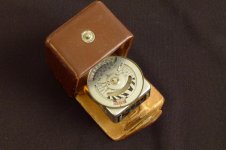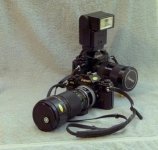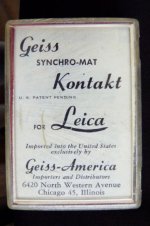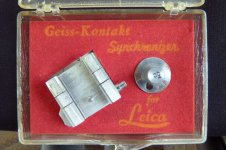I've been around a lot of years, and for most of them, I've enjoyed photography. My equipment has changed a LOT over the years.
In the beginning, there was my Donald Duck camera. I remember I made a photo of the first flag raising at my new grammar school with it. The print was tiny, and the camera had no adjustments whatsoever. The year was 1948. I wish I had a copy of that photo today; I'd donate it to the school. Alas, it and the camera are long gone.
In my high school years, I had an Ansco 120 box camera. Point and shoot. Hold it at waist level, look through the viewfinder (there were two, one for vertical and one for horizontal shots) and press the shutter lever. A camera that couldn't be more simple. I did get some shots of my high school sweetheart, who eventually asked me to marry her. I treasure those photos today.
My dad had, in the middle 1950s, purchased a Leica IIIf 35 mm camera. It was state of the art then. It had a focal plane shutter, a rangefinder for focus, and interchangeable lenses. He handed down his old Bolsey 35mm between-the-fixed-lens shuttered camera to me; it had a (then) wide-angle 35mm lens. It was usable. I had a cheap exposure meter which allowed me to man the controls and make some decent shots. I used it through college and when I was in the Army. Occasionally, dad would let me use his Leica. Here it is in all its glory:

The Leica was excellent and the lenses were Zeiss sharp. He used three - a 35mm, a 50mm, and a 135mm. During high school, I bought some used darkroom equipment, including an enlarger. Dad and I had fun setting everything up at night in mom's kitchen. She complained about the chemical smell and the chemicals in the refrigerator, but we managed to get some nice photo work done. I took a photography course in college, and a shot of my best buddy and beloved dog Rags with his head on my tennis shoe won me a prize in the local newspaper's photo contest.

After the Army, I was too busy earning a living and raising a family to bother much with photo equipment; the old Bolsey sufficed. I now wish I had much better equipment when I visited Springfield Armory, Aberdeen Proving Grounds, Gettysburg, Valley Forge and Independence Hall. At any rate, I finally decided I needed a REAL camera - a 35mm single lens reflex. We were living in El Paso at the time (early '80s), and they had a sales special at K-Mart on the Pentax K1000 camera. This was an SLR with interchangeable lenses, needle-matching internal exposure meter, and plenty of exposure latitude. It was a beginner's SLR, but fully capable on a par with much more expensive cameras. I had some exotic lenses, but the old reliable 50 mm f/1.4 Pentax lens was a beauty and quite sharp. Here is that venerable camera:

In the meantime, the digital revolution had begun, and it had a lot to recommend it over film. No more waiting for days while your shots were being developed, and finding out you had flubbed an important one. If you had a computer, you could download the pictures immediately, and if you wanted a print you could do it on your computer's color printer. This was heady stuff.
In 2005 I took the plunge with a little Kodak point-and-shoot digital. I think it took 4 megapixel pictures. It did work after a fashion, but then it went crazy and the electronics in it failed. I was used to an SLR, and went on a quest for a digital SLR.
I already had a plethora of Pentax lenses, and Pentax had a reputation for offering the most bang for the buck. In 2006, I checked around and decided that their K100D camera might suit my needs. It offered 6 megapixel photos, and was powered by AA batteries. That seemed to make sense - I would never be far from power for the camera. It came with an 18-55mm zoom, and I could use my legacy Pentax-compatible lenses. I took many shots with it, including many of my 90-plus year-old mother that I treasure today. When I moved up to a better camera, I passed it on to one of my granddaughters who was developing a talent for photography.
My next camera was a Pentax K200D - a 10 megapixel number with many advanced capabilities, also powered by AA batteries. I got it in late 2008. Here's a shot of it:

As I launched my retirement avocation/career as a free-lance gun writer, I wanted more quality and capability in a camera, and when the Pentax K-5 came along in late 2010, I was entranced. Here was a 16 MP camera with incredible features. Most of the pictures I've taken for posting here on this forum were with the K-5. It's powered by a rechargeable battery, or with an attachable battery grip, six AA batteries. Here's a pic of it:

When my wife and I traveled to Hawaii for our 50th wedding anniversary, the K-5 and an 18-135mm zoom lens came along. I got some great shots.
In October of this year, Pentax announced the new K-3 24 MP camera. While most modern digital cameras have an anti-aliasing filter in front of the sensor, the downside is that the resulting pictures are not as sharp as they could be without the filter. This camera will let you shoot with or without an AA filter, selectable with the camera's software. This baby has all the bells and whistles, including an amazing 8-per-second repeat shot rate. I won't go into all the things it can do; Google it and see what you think. I personally think it's at the pinnacle of current digital technology. It's powered similarly to the K-5 and uses many of the same attachments. All Pentax DLSRs mentioned so far have body-based image stabilization and can use any Pentax K-mount lens ever made. Mine came in from B&H Photo by UPS on Nov. 13th. Here's a pic of my latest camera pride and joy - it should probably last me for the rest of my life:

From here on in, I'll be using the K-3. My post on the Krag rifle recently had pictures shot with the K3; I find them noticeably sharper than those from the K-5, and they can be blown up to nearly wall size if I want.
For all of that, I find DSLRs cumbersome to carry around to gatherings such as reunions and parties. For that purpose I'll have to admit I use a small point and shoot. This 10 MP Canon A1000IS serves the need; it can be slipped into a pocket easily, and I can post down-sized photos to my friends easily. This one actually has an optical viewfinder that you can look through; I don't have to be re-trained to hold it up and look at the backside display to frame my photos. By the way, I prefer Canon quality to Nikon. I bought my wife a Nikon point-and-shoot; it turned out to be clumsy to operate and adjust and had a habit of dumping its batteries on the ground - usually an unexpected surprise.

Well, that's my photo equipment summary - hope you enjoyed the nostalgic trip. Incidentally, I have a Pentax photo album on-line here if you are interested:
PENTAX : PENTAX Photo Gallery artist page
John
In the beginning, there was my Donald Duck camera. I remember I made a photo of the first flag raising at my new grammar school with it. The print was tiny, and the camera had no adjustments whatsoever. The year was 1948. I wish I had a copy of that photo today; I'd donate it to the school. Alas, it and the camera are long gone.
In my high school years, I had an Ansco 120 box camera. Point and shoot. Hold it at waist level, look through the viewfinder (there were two, one for vertical and one for horizontal shots) and press the shutter lever. A camera that couldn't be more simple. I did get some shots of my high school sweetheart, who eventually asked me to marry her. I treasure those photos today.
My dad had, in the middle 1950s, purchased a Leica IIIf 35 mm camera. It was state of the art then. It had a focal plane shutter, a rangefinder for focus, and interchangeable lenses. He handed down his old Bolsey 35mm between-the-fixed-lens shuttered camera to me; it had a (then) wide-angle 35mm lens. It was usable. I had a cheap exposure meter which allowed me to man the controls and make some decent shots. I used it through college and when I was in the Army. Occasionally, dad would let me use his Leica. Here it is in all its glory:

The Leica was excellent and the lenses were Zeiss sharp. He used three - a 35mm, a 50mm, and a 135mm. During high school, I bought some used darkroom equipment, including an enlarger. Dad and I had fun setting everything up at night in mom's kitchen. She complained about the chemical smell and the chemicals in the refrigerator, but we managed to get some nice photo work done. I took a photography course in college, and a shot of my best buddy and beloved dog Rags with his head on my tennis shoe won me a prize in the local newspaper's photo contest.

After the Army, I was too busy earning a living and raising a family to bother much with photo equipment; the old Bolsey sufficed. I now wish I had much better equipment when I visited Springfield Armory, Aberdeen Proving Grounds, Gettysburg, Valley Forge and Independence Hall. At any rate, I finally decided I needed a REAL camera - a 35mm single lens reflex. We were living in El Paso at the time (early '80s), and they had a sales special at K-Mart on the Pentax K1000 camera. This was an SLR with interchangeable lenses, needle-matching internal exposure meter, and plenty of exposure latitude. It was a beginner's SLR, but fully capable on a par with much more expensive cameras. I had some exotic lenses, but the old reliable 50 mm f/1.4 Pentax lens was a beauty and quite sharp. Here is that venerable camera:

In the meantime, the digital revolution had begun, and it had a lot to recommend it over film. No more waiting for days while your shots were being developed, and finding out you had flubbed an important one. If you had a computer, you could download the pictures immediately, and if you wanted a print you could do it on your computer's color printer. This was heady stuff.
In 2005 I took the plunge with a little Kodak point-and-shoot digital. I think it took 4 megapixel pictures. It did work after a fashion, but then it went crazy and the electronics in it failed. I was used to an SLR, and went on a quest for a digital SLR.
I already had a plethora of Pentax lenses, and Pentax had a reputation for offering the most bang for the buck. In 2006, I checked around and decided that their K100D camera might suit my needs. It offered 6 megapixel photos, and was powered by AA batteries. That seemed to make sense - I would never be far from power for the camera. It came with an 18-55mm zoom, and I could use my legacy Pentax-compatible lenses. I took many shots with it, including many of my 90-plus year-old mother that I treasure today. When I moved up to a better camera, I passed it on to one of my granddaughters who was developing a talent for photography.
My next camera was a Pentax K200D - a 10 megapixel number with many advanced capabilities, also powered by AA batteries. I got it in late 2008. Here's a shot of it:

As I launched my retirement avocation/career as a free-lance gun writer, I wanted more quality and capability in a camera, and when the Pentax K-5 came along in late 2010, I was entranced. Here was a 16 MP camera with incredible features. Most of the pictures I've taken for posting here on this forum were with the K-5. It's powered by a rechargeable battery, or with an attachable battery grip, six AA batteries. Here's a pic of it:

When my wife and I traveled to Hawaii for our 50th wedding anniversary, the K-5 and an 18-135mm zoom lens came along. I got some great shots.
In October of this year, Pentax announced the new K-3 24 MP camera. While most modern digital cameras have an anti-aliasing filter in front of the sensor, the downside is that the resulting pictures are not as sharp as they could be without the filter. This camera will let you shoot with or without an AA filter, selectable with the camera's software. This baby has all the bells and whistles, including an amazing 8-per-second repeat shot rate. I won't go into all the things it can do; Google it and see what you think. I personally think it's at the pinnacle of current digital technology. It's powered similarly to the K-5 and uses many of the same attachments. All Pentax DLSRs mentioned so far have body-based image stabilization and can use any Pentax K-mount lens ever made. Mine came in from B&H Photo by UPS on Nov. 13th. Here's a pic of my latest camera pride and joy - it should probably last me for the rest of my life:

From here on in, I'll be using the K-3. My post on the Krag rifle recently had pictures shot with the K3; I find them noticeably sharper than those from the K-5, and they can be blown up to nearly wall size if I want.
For all of that, I find DSLRs cumbersome to carry around to gatherings such as reunions and parties. For that purpose I'll have to admit I use a small point and shoot. This 10 MP Canon A1000IS serves the need; it can be slipped into a pocket easily, and I can post down-sized photos to my friends easily. This one actually has an optical viewfinder that you can look through; I don't have to be re-trained to hold it up and look at the backside display to frame my photos. By the way, I prefer Canon quality to Nikon. I bought my wife a Nikon point-and-shoot; it turned out to be clumsy to operate and adjust and had a habit of dumping its batteries on the ground - usually an unexpected surprise.

Well, that's my photo equipment summary - hope you enjoyed the nostalgic trip. Incidentally, I have a Pentax photo album on-line here if you are interested:
PENTAX : PENTAX Photo Gallery artist page
John
Last edited:









